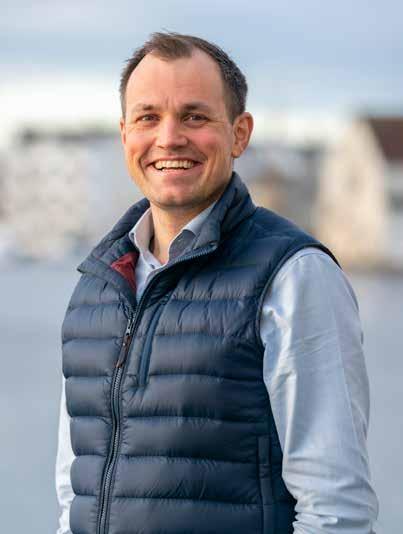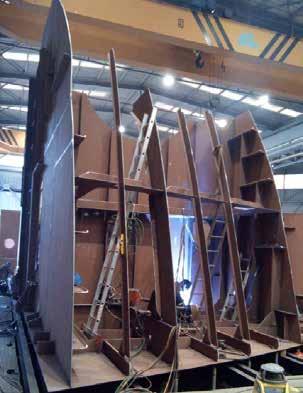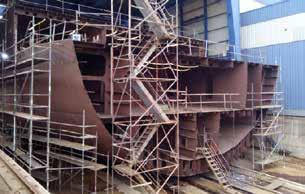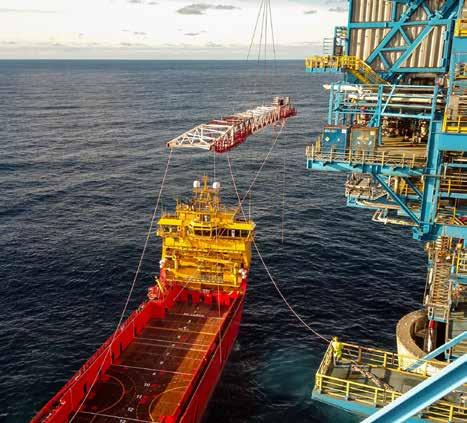
5 minute read
From speculations to tangible realities

Chartering Manager Offshore Wind, Håkon Vevang Steel block assembly at the yard in Spain
Advertisement

The shape of a vessel. Steel blocks forming a vessel on the bedding.

It was noticed in the offshore wind market when Østensjø ordered four new SOV/CSOV’s on speculation in October, 2019. The vessels are designed for advanced operations in European offshore wind farms, with high ambitions for zero emissions. - A clear signal to the industry that we’re set on long-term commitment in this market, says Håkon Vevang, Chartering Manager Offshore Wind.
A year later, the construction of the four advanced SOV/CSOV’s is well underway at the two northern Spanish shipyards Astilleros Gondan and Astilleros Balenciaga. Håkon Vevang concludes that everything is going as planned, in spite of the pandemic ravaging Spain. The first two vessels are set to be delivered in March and April 2022, the second two by the end of that year.
CONTRACTS FOR 15 AND 11 YEARS
Vevang tells us that they have secured 15 and 11 year contracts for the first two vessels. The longest contract is with MHI Vestas, for an SOV with a capacity of up to 40 turbine technicians. This ship will be based out of Montrose and will operate on the Seagreen Offshore Wind Farm outside the east coast of Scotland. - MHI Vestas is the world’s second-largest producer of offshore turbines, making them an interesting client for Edda Wind, remarks Vevang. The second vessel has been contracted to German Ocean Breeze for ten years and will operate on the Bard 1 wind farm in German waters. - We assume intense work is ongoing to secure contracts for the remaining two ships? - I’m confident we’ll be able to put them to work as well, he says. It is obviously too soon to make remarks on potential clients. In keeping with shipping traditions, contracts are discussed when firmly in hand.
SOME LOCAL CREWS
- Do the contracts for the first two vessels suggest that you must accept local demands crewing of the vessel? - In the agreement with MHI Vestas we’ve promised some local crew, the rest is yet to be decided. For the ship operating in the German sector, nothing has been determined as of yet. He expects Østensjø will establish a local project organization in Spain by February/March, depending on how the COVID-19-situation develops.
FRA SPEKULASJON TIL HÅNDFASTE REALITETER
Det ble lagt merke til i offshore vind-bransjen at Østensjø Rederi i oktober 2019 på spekulasjon bestilte fire nye SOV/ CSOV, spesialdesignet for avanserte operasjoner i europeiske offshorevindfarmer og med høye ambisjoner om lavutslipp. - Et klart signal til bransjen om at vi var innstilt på en langsiktig satsing i dette markedet, sier Håkon Vevang, Chartering Manager Offshore Wind.
Etter år seinere er byggingen av de fire avanserte SOV/ CSOV’ene godt i gang på de to nord-spanske verftene Astilleros Gondan og Astilleros Baleciaga. Håkon Vevang slår fast at alt går etter planen trass de heftige pademibølgene i Spania. De to første skipene skal leveres i mars og april 2022, de to andre før årsskiftet samme år. Vevang forteller at de to første spesialfartøyene er sikret 15- og 11 årskontrakter. Den lengste kontrakten er gjort med MHI Vestas, og er for en SOV med kapasitet for inntil 40 turbinteknikere. Dette skipet skal ha Montrose som base og operere på Seagreen Offshore Wind Farm.
SMALL STEPS TOWARD INCREASED EFFECTIVENESS
- These four vessels will be even more specialized than Edda Passat and Edda Mistral? - We’ve learned a lot from these two vessels. The logistics onboard are improved, both for crew and cargo, the walkway systems and cranes are developed further. We’re not talking about revolutionary improvements, but simple changes to increase the effectiveness and the operability of the ships. A significant difference is that the ships are built with propulsion systems from Voith Schneider. This considerably affects the dynamic positioning, enabling the ships to safely perform their tasks in much rougher weather conditions, which is a great advantage for our clients, and us as a supplier.
A GAME-CHANGER
At the same time, Håkon Vevang points to the fact that all four ships are being built with battery hybrid technology, and are being prepared to run on hydrogen. The plan is for the ships to run emissions-free in the next 3-5 years. - This is going to be a game-changer in our industry. It’s incredible that technology has come so far that we’ll soon be able to offer emissions-free vessels to the offshore market, he says. The environmental fund of the Norwegian government, Enova, has given an important financial contribution to this investment in environmentally friendly technology.
MORE TIME
- Likely, many of our competitors wish they were in the financial position to make this kind of investment. Luckly, we’re in a position where we can still get banks and investors on board to projects like this. Our financial situation enables us to time the investments right, and to position us well in the market, smiles a busy Håkon Vevang, before checking his watch and running off to another meeting.
- MHIVestas er verdens nest største produsent av offshoreturbiner, og er en god og interessant kunde for Edda Wind, bemerker Vevang. Båt nr 2 er utleid i 11 år til Ocean Breeze i Tyskland og skal arbeide i vindfarmen Bard 1 som ligger i tysk farvann. - Disse fire fartøyene blir enda mer spesialisert enn Edda Passat og Edda Mistral…? - Vi har lært mye av erfaringene med disse to fartøyene. Logistikken om bord for last og folk, er forbedret, gangveisystemene og kraner videreutviklet. Det er ikke snakk om revolusjonerende forbedringer, men enkelte endringer for å øke effektiviteten og operabiliteten til skipene. En vesentlig forskjell er at skipene bygges med fremdriftssystemer fra Voith Schneider. Dette gir signifikant effekt på den dynamiske posisjoneringen , slik at fartøyene trygt kan utføre sine oppgaver i vesentlig tøffere værforhold, en stor fordel for kundene våre og et fortrinn for oss som leverandør. Håkon Vevang peker samtidig på at alle fire skipene bygges med batteri hybrid teknologi og blir klargjort for hydrogen-drift. Planen er at skipene skal kunne drives utslippsfritt i løpet av 3 til 5 år. - Dette kommer til å bli en «game changer» i vår industri, slår han blant annet fast.










